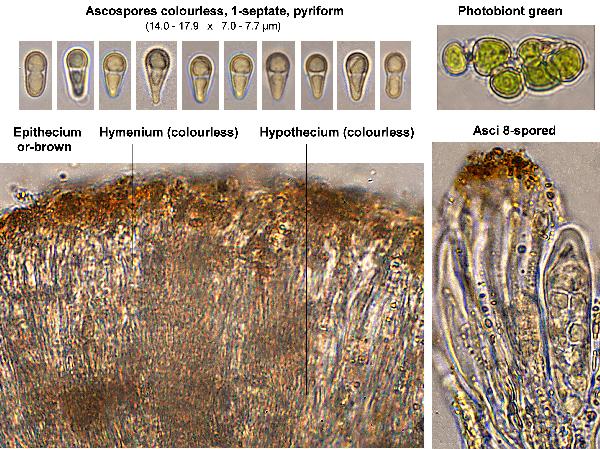Gyalolechia canariensis (Follmann & Poelt) Søchting, Frödén & Arup
in Arup & al., Nord. J. Bot., 31: 70, 2013. Basionym: Fulgensia canariensis Follmann & Poelt - Philippia, 4/5: 372, 1981.
Synonyms: Caloplaca canariensis (Follmann & Poelt) Breuss
Distribution: C - Sar.
Description: Thallus crustose, episubstratic, orange-yellow, areolate; areoles angular or sometimes sublobulate, convex, contiguous, the surface smooth, corticate; lower surface attached to the substrate by long hyphal strands. Cortical cells strongly gelatinized, irregularly arranged, with up to 2 µm wide and up to 15 µm long, tubular lumina, overlain by a colourless, 15-20 µm thick epinecral layer; algal layer continuous. Apothecia zeorine, sessile, up to 1.5 mm across, with a dark orange to orange-brown, flat, smooth, disc and a thin, orange-yellow margin. Thalline exciple finally limited to the basal part of apothecia; proper exciple of radiating hyphae with moderately thick walls and long and narrow lumina; epithecium orange-brown, K+ red; hymenium colourless; paraphyses simple or sparingly branched, 1-2 µm thick at mid-level, the apical cells slightly wider. Asci 8-spored, clavate, functionally unitunicate, apically thickened with a broad internal beak, the inner part of apex and external cap I+ blue, Teloschistes-type. Ascospores 2-celled, not clearly polarilocular but the equatorial thickening (“septum”) often incomplete, hyaline, pyriform, 12-17 x 5-7.5 µm. Pycnidia orange-yellow, immersed. Conidia bacilliform. Photobiont chlorococcoid. Spot tests: thallus and apothecia K+ red, C-, KC-, P-. Chemistry: fragilin dominant, with smaller amounts of emodin and parietin, plus caloploicin, vicanicin and isofulgidin.Note: a xeric subtropical lichen found on base-rich clay soil in clearings of grasslands and scrublands, common in Macaronesia and also known from North Africa; in Europe only known from a single station in central Sardinia (Gennargentu Massif near Desulo).
Growth form: Crustose
Substrata: soil, terricolous mosses, and plant debris
Photobiont: green algae other than Trentepohlia
Reproductive strategy: mainly sexual
Commonnes-rarity: (info)
Alpine belt: absent
Subalpine belt: absent
Oromediterranean belt: absent
Montane belt: absent
Submediterranean belt: extremely rare
Padanian area: absent
Humid submediterranean belt: absent
Humid mediterranean belt: absent
Dry mediterranean belt: absent
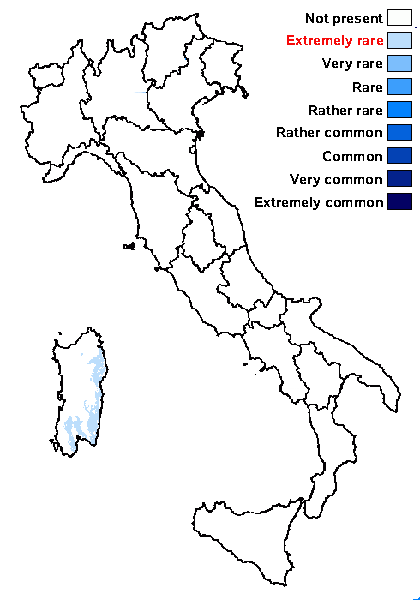
Predictive model
Herbarium samples
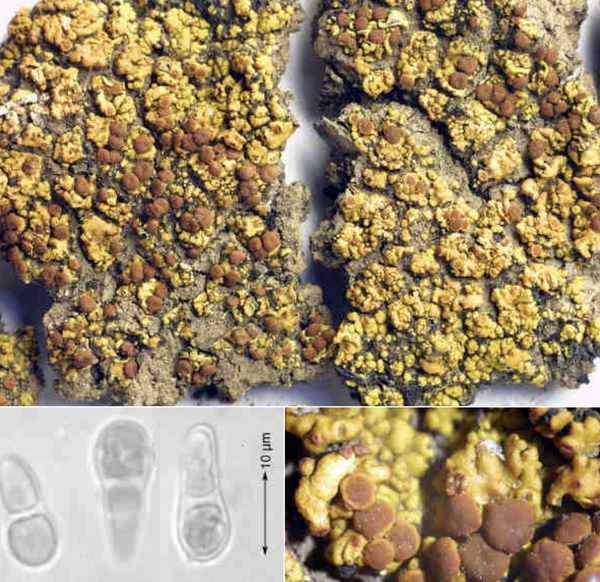

Felix Schumm – CC BY-SA 4.0
Image from: F. Schumm (2008) - Flechten Madeiras, der Kanaren und Azoren. Beck, OHG - ISBN: 978-3-00-023700-3
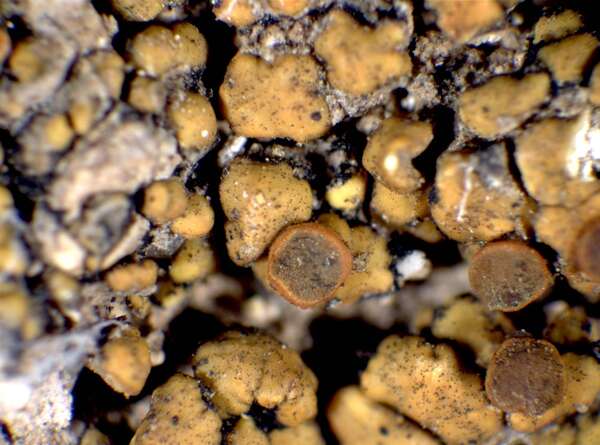

P.L. Nimis; Owner: Department of Life Sciences, University of Trieste
Herbarium: TSB (18200)
2001/11/24
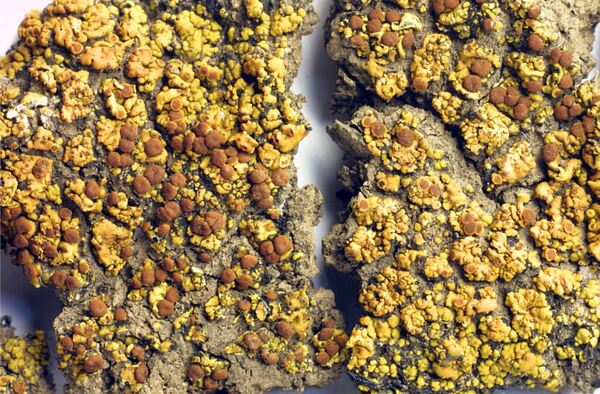

Felix Schumm - CC BY-SA 4.0
Image from: F. Schumm (2008) - Flechten Madeiras, der Kanaren und Azoren. Beck, OHG - ISBN: 978-3-00-023700-3
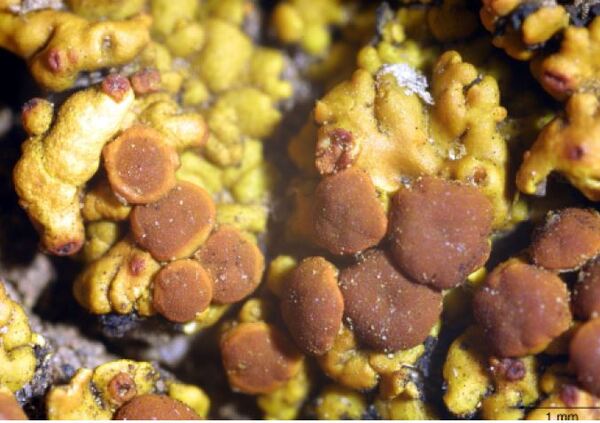

Felix Schumm - CC BY-SA 4.0
Image from: F. Schumm (2008) - Flechten Madeiras, der Kanaren und Azoren. Beck, OHG - ISBN: 978-3-00-023700-3
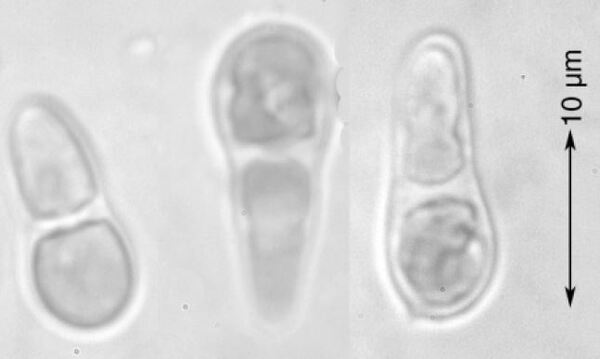

Felix Schumm - CC BY-SA 4.0
Image from: F. Schumm (2008) - Flechten Madeiras, der Kanaren und Azoren. Beck, OHG - ISBN: 978-3-00-023700-3
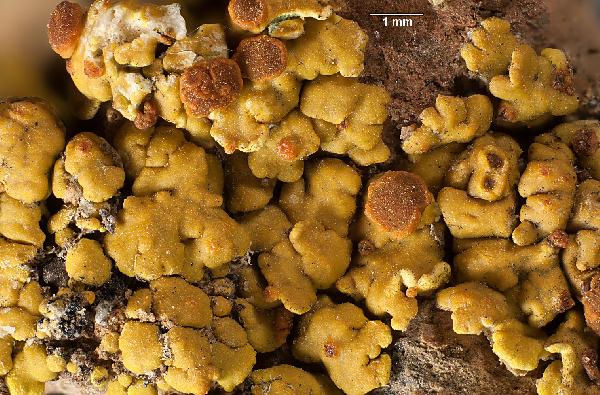
Ulrich Kirschbaum CC BY-SA 4.0 - Source: https://www.thm.de/lse/ulrich-kirschbaum/flechtenbilder
E; Canary Islands; La Gomera-S ; nne of Santiago: hiking path between El Rumbazo and Targa
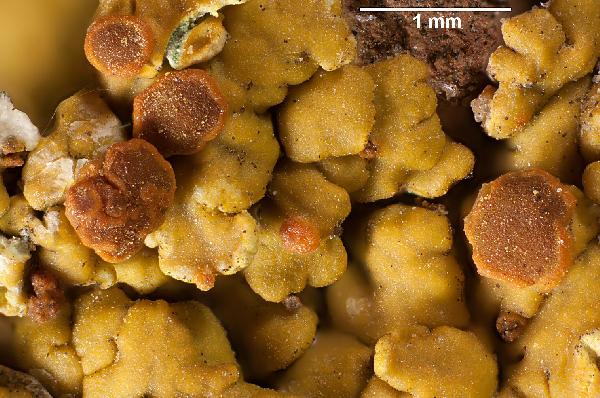
Ulrich Kirschbaum CC BY-SA 4.0 - Source: https://www.thm.de/lse/ulrich-kirschbaum/flechtenbilder
E; Canary Islands; La Gomera-S ; nne of Santiago: hiking path between El Rumbazo and Targa
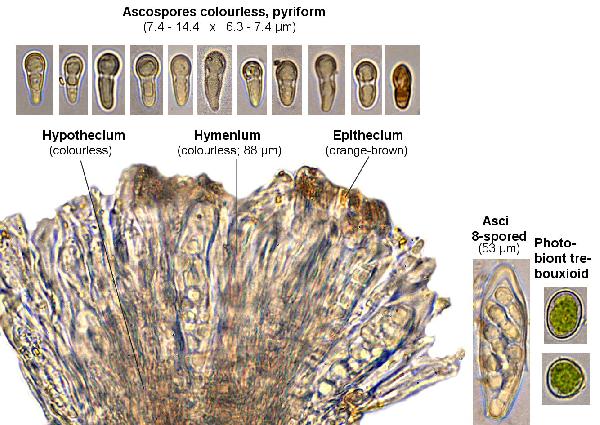
Ulrich Kirschbaum CC BY-SA 4.0 - Source: https://www.thm.de/lse/ulrich-kirschbaum/flechtenbilder
E; Canary Islands; La Gomera-S ; nne of Santiago: hiking path between El Rumbazo and Targa
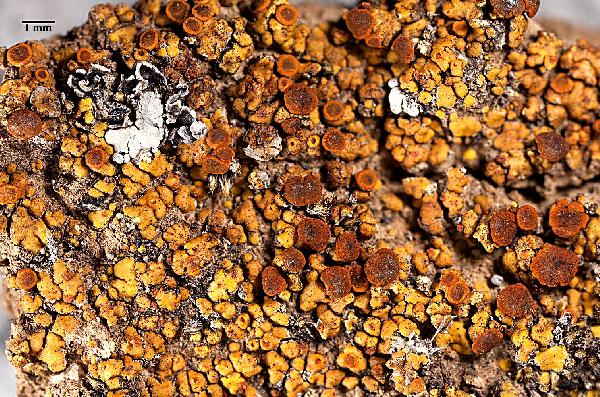
Ulrich Kirschbaum CC BY-SA 4.0 - Source: https://www.thm.de/lse/ulrich-kirschbaum/flechtenbilder
E; Canary Islands; La Gomera-MSW; se of Chipude: at Fortaleza.

Ulrich Kirschbaum CC BY-SA 4.0 - Source: https://www.thm.de/lse/ulrich-kirschbaum/flechtenbilder
E; Canary Islands; La Gomera-MSW; se of Chipude: at Fortaleza.
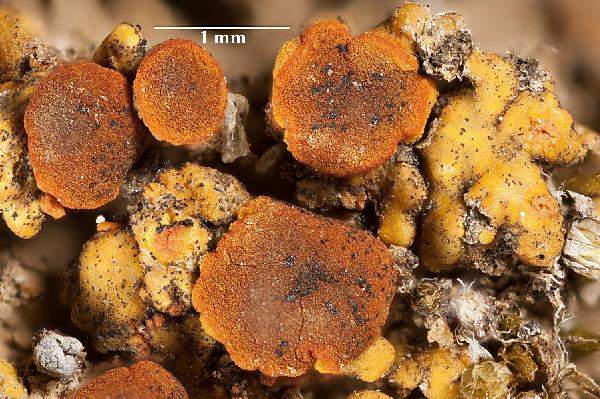
Ulrich Kirschbaum CC BY-SA 4.0 - Source: https://www.thm.de/lse/ulrich-kirschbaum/flechtenbilder
E; Canary Islands; La Gomera-MSW; se of Chipude: at Fortaleza.
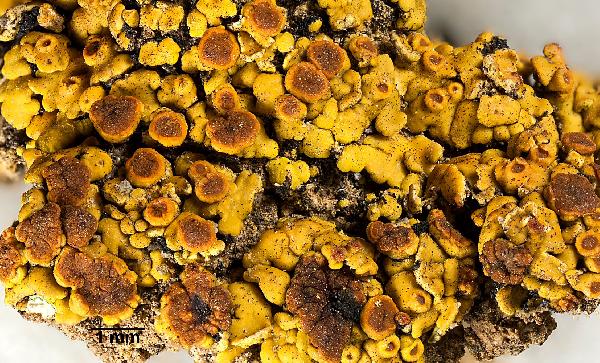
Ulrich Kirschbaum CC BY-SA 4.0 - Source: https://www.thm.de/lse/ulrich-kirschbaum/flechtenbilder
E; Canary Islands; La Gomera-MS; e of Imada: El Azadoe.

Ulrich Kirschbaum CC BY-SA 4.0 - Source: https://www.thm.de/lse/ulrich-kirschbaum/flechtenbilder
E; Canary Islands; La Gomera-MS; e of Imada: El Azadoe.
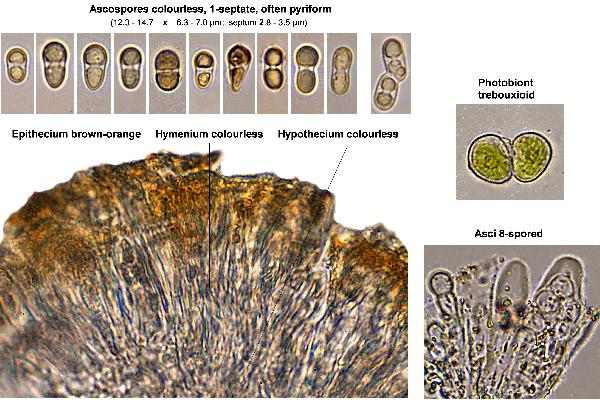
Ulrich Kirschbaum CC BY-SA 4.0 - Source: https://www.thm.de/lse/ulrich-kirschbaum/flechtenbilder
E; Canary Islands; La Gomera-MS; e of Imada: El Azadoe.
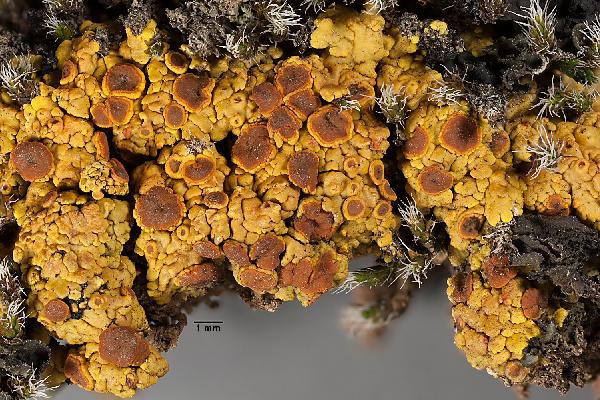
Ulrich Kirschbaum CC BY-SA 4.0 - Source: https://www.thm.de/lse/ulrich-kirschbaum/flechtenbilder
On strongly eroded volcanic rocks.
E; Canary Islands; La Gomera-MSW; ese of Chipude: hiking path between Fortaleza and Igualero; se of the little brook.
Growth form: Crustose
Substrata: soil, terricolous mosses, and plant debris
Photobiont: green algae other than Trentepohlia
Reproductive strategy: mainly sexual
Commonnes-rarity: (info)
Alpine belt: absent
Subalpine belt: absent
Oromediterranean belt: absent
Montane belt: absent
Submediterranean belt: extremely rare
Padanian area: absent
Humid submediterranean belt: absent
Humid mediterranean belt: absent
Dry mediterranean belt: absent

Predictive model
| Herbarium samples |


Felix Schumm – CC BY-SA 4.0
Image from: F. Schumm (2008) - Flechten Madeiras, der Kanaren und Azoren. Beck, OHG - ISBN: 978-3-00-023700-3


P.L. Nimis; Owner: Department of Life Sciences, University of Trieste
Herbarium: TSB (18200)
2001/11/24


Felix Schumm - CC BY-SA 4.0
Image from: F. Schumm (2008) - Flechten Madeiras, der Kanaren und Azoren. Beck, OHG - ISBN: 978-3-00-023700-3


Felix Schumm - CC BY-SA 4.0
Image from: F. Schumm (2008) - Flechten Madeiras, der Kanaren und Azoren. Beck, OHG - ISBN: 978-3-00-023700-3


Felix Schumm - CC BY-SA 4.0
Image from: F. Schumm (2008) - Flechten Madeiras, der Kanaren und Azoren. Beck, OHG - ISBN: 978-3-00-023700-3

Ulrich Kirschbaum CC BY-SA 4.0 - Source: https://www.thm.de/lse/ulrich-kirschbaum/flechtenbilder
E; Canary Islands; La Gomera-S ; nne of Santiago: hiking path between El Rumbazo and Targa

Ulrich Kirschbaum CC BY-SA 4.0 - Source: https://www.thm.de/lse/ulrich-kirschbaum/flechtenbilder
E; Canary Islands; La Gomera-S ; nne of Santiago: hiking path between El Rumbazo and Targa

Ulrich Kirschbaum CC BY-SA 4.0 - Source: https://www.thm.de/lse/ulrich-kirschbaum/flechtenbilder
E; Canary Islands; La Gomera-S ; nne of Santiago: hiking path between El Rumbazo and Targa

Ulrich Kirschbaum CC BY-SA 4.0 - Source: https://www.thm.de/lse/ulrich-kirschbaum/flechtenbilder
E; Canary Islands; La Gomera-MSW; se of Chipude: at Fortaleza.

Ulrich Kirschbaum CC BY-SA 4.0 - Source: https://www.thm.de/lse/ulrich-kirschbaum/flechtenbilder
E; Canary Islands; La Gomera-MSW; se of Chipude: at Fortaleza.

Ulrich Kirschbaum CC BY-SA 4.0 - Source: https://www.thm.de/lse/ulrich-kirschbaum/flechtenbilder
E; Canary Islands; La Gomera-MSW; se of Chipude: at Fortaleza.

Ulrich Kirschbaum CC BY-SA 4.0 - Source: https://www.thm.de/lse/ulrich-kirschbaum/flechtenbilder
E; Canary Islands; La Gomera-MS; e of Imada: El Azadoe.

Ulrich Kirschbaum CC BY-SA 4.0 - Source: https://www.thm.de/lse/ulrich-kirschbaum/flechtenbilder
E; Canary Islands; La Gomera-MS; e of Imada: El Azadoe.

Ulrich Kirschbaum CC BY-SA 4.0 - Source: https://www.thm.de/lse/ulrich-kirschbaum/flechtenbilder
E; Canary Islands; La Gomera-MS; e of Imada: El Azadoe.

 Index Fungorum
Index Fungorum
 GBIF
GBIF

